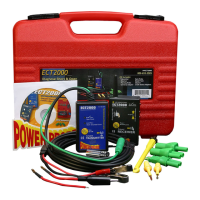20
ECT-2000
F
AT
No matter what side of the circuit
ou test, the RECEIVE
will indicate the direction to the short or
round
observe LED indicator
No im
orta el lado del circuito en
ue este
robando, el rece
tor indicara la direcc
ón
a se
uir hasta el corto o tierra
Observe el indicador LED
Signal drops at the
point of the short circuit.
La señal se cae en el
punto del corto en el circuito
TRACING SHORT CIRCUITS
To locate a short circuit, remove the blown fuse and connect the appropriate
adapter into the fuse socket. Connect the transmitter to the adapter. It may be
necessary to turn the vehicle's ignition switch on to activate the circuit. You can
see that the transmitter is working by hearing it cycle through its tests and observing its LED indicators. Take the
"SMART" receiver and turn it on. Move the "SMART" receiver around the circuit in question until you receive a signal.
Keep in mind that the SMART receiver is direction sensitive. This means that the signal reception is the strongest when
the OPEN & SHORT PICK-UP is parallel to the circuit. The pulsing signal will increase in PPM (pulses per minute) the
closer you get to the wire or circuit. The pulsing signal will decrease the further away you get from the circuit. If desired,
you can lock the threshold. (See LOCKING THE RECEPTION DISTANCE page 19) Follow the signal in the direction of
the arrow. When you come to the short, the receiver will stop beeping as you pass it. Search this area for the short. You
may find it useful to cut the wire and probe the circuit using a Power Probe circuit tester. (see "Following and locating
short circuits" on page 12). or you can reconnect the transmitter directly to the circuit. This may isolate other parallel
circuits that could be conducting some of the signal. In the case of an obstacle, such as a back seat blocking the way, try
opening the trunk and checking for a signal on that side. This may save you a lot of time in removing the obstacle. As
long as the receiver is receiving a signal, it will remain on. When it is not receiving a signal it will shut-off after 30
seconds.
RASTREANDO CIRCUITOS EN CORTO
Para localizar un corto en un circuito, remueva el fusible fundido y conecte el adaptador apropiado en el receptáculo del
fusible. Conecte el transmisor al adaptador. Puede ser necesario girar el interruptor de encendido para activar el
circuito. Usted puede ver que el transmisor esta funcionando escuchando su ciclo a través de sus pruebas y
observando sus indicadores LED's. Tome el receptor "SMART" y enciéndalo. Mueva el receptor "SMART" alrededor del
circuito en cuestión hasta que reciba una señal. Mantenga en mente que el receptor "SMART" es sensitivo a la
dirección. Esto significa que la recepción de la señal es más fuerte cuando el captador de cortos y aperturas esta
paralelo al circuito. La señal pulsante aumentara en PPM (pulsos por minuto) mientras mas cercano este al alambre o
circuito. La señal pulsante disminuirá mientras mas se aleje del circuito. Si se desea se puede cerrar el punto de
comienzo. (VEA CERRANDO LA DISTANCIA DE RECEPCION pagina 19). Siga la señal en la dirección de la flecha.
Cuando llegue al corto, el receptor parara el "Biping" al pasarse. Busque el corto en esta área. Usted puede encontrar
útil el corta el alambre y sondear el circuito utilizando un probador de circuito Power Probe. (Vea "Siguiendo y
localizando circuitos en corto" en la pagina 12). O usted puede reconectar el transmisor directamente al circuito. Esto
puede aislar otros circuitos paralelos que pueden estar conduciendo parte de la señal. En caso de obstáculos, tal como
un asiento trasero bloqueando el paso, trate abriendo el maletero (baúl) y continué probando la señal en ese lado. Esto
puede ahorrarle mucho tiempo al no remover el obstáculo. Mientras el receptor siga recibiendo la señal, este continuara
activo. Cuando no este recibiendo la señal, este se apagara después de 30 segundos
Tracing short circuits
R
r
n
r
n
ir
i

